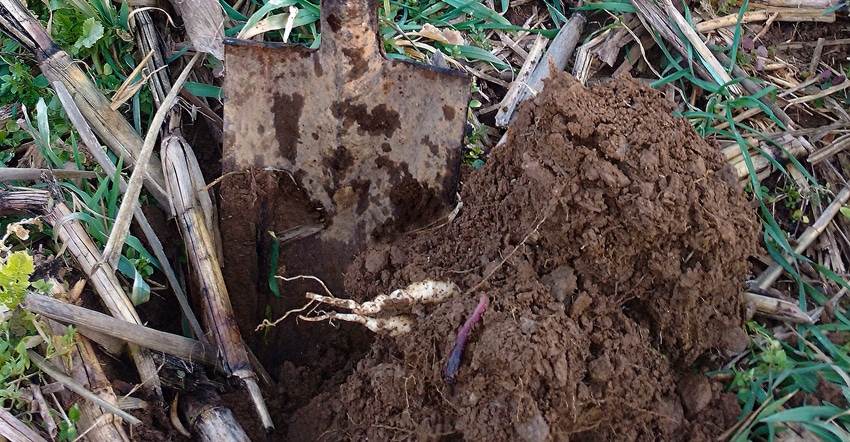January 10, 2020

Carbon, nitrogen and phosphorus all play critical roles in supporting healthy soils, maintaining crop yields and affecting the environment.
Optimal management of these elements would lead to high soil carbon levels, low nitrate leaching and phosphorus that is maintained at a balanced level. However, this is challenging.
A research project funded by Northeast SARE (Sustainable Agriculture Research and Education) is looking at management strategies to help balance these crucial soil nutrients.
One of the easiest ways to raise soil carbon levels is by increasing manure applications. However, this can lead to excess phosphorus, and poorly timed manure applications can lead to nitrate leaching.
Similarly, no-till can increase soil carbon levels at the soil surface but carbon levels in the subsoil may decline, and surface applications of manure can lead to phosphorus stratification and increased risk of soluble phosphorus runoff.
Some of the questions this project seeks to answer are: Is there a combination of management strategies that together can allow for high soil carbon, low nitrate leaching and phosphorus in balance? If so, what is that combination of practices, and how high would the soil carbon levels be under that type of management?
Sampling fields
A research team is sampling farm fields in Pennsylvania, Maryland and New York that have been under a range of production practices. Carbon, nitrate and Mehlich-3 extractable phosphorus are being measured in the soil profile to a depth of 32 inches to determine how management practices on these farms influence carbon-nitrogen-phosphorus dynamics.
The farming systems span from tillage to long-term no-till, and from nitrogen-based manure application rates applied annually to lower-rate or less-frequent manure applications, or solely chemical-fertilizer managed systems.
Cover crops are also being evaluated for managing residue cover and to see how supplemental forage production can influence C-N-P dynamics. For instance, a cover crop harvested for forage may help to optimize C-N-P dynamics by preventing nitrate leaching, adding soil carbon in the root mass and removing more P from the soil, which allows for higher P-based manure rates that also increase C inputs.
Looking at data
The farming systems under study also vary in crop rotation practices, from simple grain rotations to complex rotations with forages and perennials.
An example of the type of data being measured in farm fields is presented below. These data are from a soil profile sampled in December on a dairy farm in central Pennsylvania. The field has been in long-term no-till with a corn silage-alfalfa hay rotation, where cereal rye is planted after each corn crop and harvested as a forage in the spring, P-balanced rates of manure are applied to the corn in fall and spring, and alfalfa in fall.

Notice the very high soil C levels that have accumulated in the surface layers but decline with depth. This decline is not necessarily a bad thing, it is just a natural characteristic of the stratification that occurs in no-till soils.
Soil nitrate levels are relatively low in the subsoil, possibly because the farm uses several adaptive N management practices and has reduced N fertilizer rates to relatively low levels while still maintaining good crop yields. The high nitrate level in the 0- to 2-inch depth is due to a fall manure application just prior to soil sampling. The cover crop planted should be able to scavenge this nitrogen before it leaches.
Finally, the Mehlich-3 P levels exhibit stratification like soil C, with high levels at the soil surface due to no-till management. This could pose a risk for P losses in some cases, but despite the stratification, since the farm uses P-balanced rates of manure it maintains average topsoil P levels only slightly above the agronomic optimum range. Overall, this farm is implementing a suite of management practices that seem to be optimizing C-N-P dynamics.
Computer modeling
Because field sampling will provide only limited snapshots of certain production practices, the research project is also using the computer simulation model Cycles to predict soil C accumulation and nitrate leaching under different management practices.
Soil sampling from the farm sites will be used to validate simulations of the computer model. Once validated, the computer model can be used to simulate how different management practices will affect C and N dynamics. One output expected from the project will be benchmark soil C levels that can be achieved under optimal C-N-P management in different soil types and climates in Pennsylvania, Maryland and New York.
In addition to the research activities, the project will host several educational events and create online tools for evaluating C-N-P management. The computer simulation model Cycles will soon be available through an online interface and will allow users to develop custom scenarios, such as different crop rotations, tillage and fertility management, and evaluate how those systems perform in each soil and climate.
Workshops to learn how to use the Cycles model will be hosted in Pennsylvania this winter. The project will also create a map of benchmark soil C levels under different management practices for agricultural soils in the Chesapeake Bay Watershed.
If you are interested in learning more about this project through periodic research updates and announcements about workshop opportunities, write to Charlie White at [email protected].
Include a few brief sentences about what you would like to learn about, and if you are a farmer, what is your crop rotation, tillage and manure management practices, and how many acres do you manage.
White is an assistant professor and Extension specialist in soil fertility and nutrient management at Penn State.
Source: Penn State Extension, which is solely responsible for the information provided and is wholly owned by the source. Informa Business Media and all its subsidiaries are not responsible for any of the content contained in this information asset.
You May Also Like




